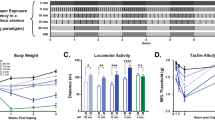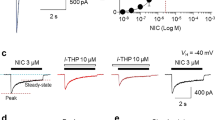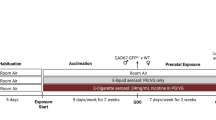Abstract
Tobacco smoke exposure during development can result in lasting alterations in sensory processing and attention. This suggests that some constituent of smoke, such as the primary addictive component, nicotine, alters neurodevelopment. Although many effects of developmental nicotine exposure have been identified in humans and animal models, very few mechanistic studies have identified the molecular and anatomical basis for a defined behavioral consequence of developmental exposure. We show in this study that a mouse model of developmental nicotine exposure results in hypersensitive passive avoidance in adulthood. We have used transgenic mice in which β2 subunit containing nicotinic acetylcholine receptors (β2* nAChRs) are expressed exclusively on corticothalamic neurons (β2 tr(CT) mice) to identify the receptor subtypes involved and also to define the circuit level site of action responsible for this persistent, nicotine-induced behavioral phenotype. Further characterization of the native nAChRs expressed in this circuit indicates that both (α4)2(β2)3 and (α4)2(β2)2α5 nAChR subtypes are present in corticothalamic projections. Consistent with a role for (α4)2(β2)2α5 nAChRs in mediating the effect of developmental nicotine exposure on adult passive avoidance behavior, constitutive deletion of the α5 nAChR subunit also alters this behavior. A critical period for this developmental consequence of nicotine exposure was defined by limiting exposure to the early post-natal period. Taken together, these studies identify a novel consequence of developmental nicotine exposure in the mouse, define the nAChR subtypes and neural circuit involved in this behavioral change and delimit the neurodevelopmental period critical for vulnerability to a behavioral alteration that persists into adulthood.
Similar content being viewed by others
Log in or create a free account to read this content
Gain free access to this article, as well as selected content from this journal and more on nature.com
or
References
Aramakis V, Hsieh C, Leslie F, Metherate R (2000). A critical period for nicotine-induced disruption of synaptic development in rat auditory cortex. J Neurosci 20: 6106–6116.
Aramakis V, Metherate R (1998). Nicotine selectively enhances NMDA receptor-mediated synaptic transmission during postnatal development in sensory neocortex. J Neurosci 18: 8485–8495.
Briggs F, Usrey W (2008). Emerging views of corticothalamic function. Curr Opin Neurobiol 18: 403–407.
Brown R, Collins A, Lindstrom J, Whiteaker P (2007). Nicotinic alpha5 subunit deletion locally reduces high-affinity agonist activation without altering nicotinic receptor numbers. J Neurochem 103: 204–215.
Caldarone B, George T, Zachariou V, Picciotto M (2000). Gender differences in learned helplessness behavior are influenced by genetic background. Pharmacol Biochem Behav 66: 811–817.
Champtiaux N, Gotti C, Cordero-Erausquin M, David D, Przybylski C, Léna C et al (2003). Subunit composition of functional nicotinic receptors in dopaminergic neurons investigated with knock-out mice. J Neurosci 23: 7820–7829.
Dobbing J, Sands J (1979). Comparative aspects of the brain growth spurt. Early Hum Dev 3: 79–83.
Fried P, Makin J (1987). Neonatal behavioural correlates of prenatal exposure to marihuana, cigarettes and alcohol in a low risk population. Neurotoxicol Teratol 9: 1–7.
Fried P, O’Connell C, Watkinson B (1992). 60- and 72-month follow-up of children prenatally exposed to marijuana, cigarettes, and alcohol: cognitive and language assessment. J Dev Behav Pediatr 13: 383–391.
Fried P, Watkinson B, Gray R (1998). Differential effects on cognitive functioning in 9- to 12-year olds prenatally exposed to cigarettes and marihuana. Neurotoxicol Teratol 20: 293–306.
Fried P, Watkinson B, Gray R (2003). Differential effects on cognitive functioning in 13- to 16-year-olds prenatally exposed to cigarettes and marihuana. Neurotoxicol Teratol 25: 427–436.
Fried P, Watkinson B, Siegel L (1997). Reading and language in 9- to 12-year olds prenatally exposed to cigarettes and marijuana. Neurotoxicol Teratol 19: 171–183.
Gaworski C, Carmines E, Faqi A, Rajendran N (2004). In utero and lactation exposure of rats to 1R4F reference cigarette mainstream smoke: effect on prenatal and postnatal development. Toxicol Sci 79: 157–169.
Girod R, Crabtree G, Ernstrom G, Ramirez-Latorre J, McGehee D, Turner J et al (1999). Heteromeric complexes of alpha 5 and/or alpha 7 subunits. Effects of calcium and potential role in nicotine-induced presynaptic facilitation. Ann N Y Acad Sci 868: 578–590.
Gotti C, Clementi F, Fornari A, Gaimarri A, Guiducci S, Manfredi I et al (2009). Structural and functional diversity of native brain neuronal nicotinic receptors. Biochem Pharmacol 78: 703–711.
Gotti C, Moretti M, Clementi F, Riganti L, McIntosh J, Collins A et al (2005a). Expression of nigrostriatal alpha 6-containing nicotinic acetylcholine receptors is selectively reduced, but not eliminated, by beta 3 subunit gene deletion. Mol Pharmacol 67: 2007–2015.
Gotti C, Moretti M, Meinerz N, Clementi F, Gaimarri A, Collins A et al (2008). Partial deletion of the nicotinic cholinergic receptor alpha 4 or beta 2 subunit genes changes the acetylcholine sensitivity of receptor-mediated 86Rb+ efflux in cortex and thalamus and alters relative expression of alpha 4 and beta 2 subunits. Mol Pharmacol 73: 1796–1807.
Gotti C, Moretti M, Zanardi A, Gaimarri A, Champtiaux N, Changeux J et al (2005b). Heterogeneity and selective targeting of neuronal nicotinic acetylcholine receptor (nAChR) subtypes expressed on retinal afferents of the superior colliculus and lateral geniculate nucleus: identification of a new native nAChR subtype alpha3beta2(alpha5 or beta3) enriched in retinocollicular afferents. Mol Pharmacol 68: 1162–1171.
Heath C, Picciotto M (2009). Nicotine-induced plasticity during development: modulation of the cholinergic system and long-term consequences for circuits involved in attention and sensory processing. Neuropharmacology 56 (Suppl 1): 254–262.
Holson R, Pearce B (1992). Principles and pitfalls in the analysis of prenatal treatment effects in multiparous species. Neurotoxicol Teratol 14: 221–228.
Hsieh C, Leslie F, Metherate R (2002). Nicotine exposure during a postnatal critical period alters NR2A and NR2B mRNA expression in rat auditory forebrain. Brain Res Dev Brain Res 133: 19–25.
Jacobsen L, Picciotto M, Heath C, Frost S, Tsou K, Dwan R et al (2007a). Prenatal and adolescent exposure to tobacco smoke modulates the development of white matter microstructure. J Neurosci 27: 13491–13498.
Jacobsen L, Slotkin T, Mencl W, Frost S, Pugh K (2007b). Gender-specific effects of prenatal and adolescent exposure to tobacco smoke on auditory and visual attention. Neuropsychopharmacology 32: 2453–2464.
Jacobsen L, Slotkin T, Westerveld M, Mencl W, Pugh K (2006). Visuospatial memory deficits emerging during nicotine withdrawal in adolescents with prenatal exposure to active maternal smoking. Neuropsychopharmacology 31: 1550–1561.
Jones E (2009). Synchrony in the interconnected circuitry of the thalamus and cerebral cortex. Ann NY Acad Sci 1157: 10–23.
Kassam S, Herman P, Goodfellow N, Alves N, Lambe E (2008). Developmental excitation of corticothalamic neurons by nicotinic acetylcholine receptors. J Neurosci 28: 8756–8764.
Katz L, Shatz C (1996). Synaptic activity and the construction of cortical circuits. Science 274: 1133–1138.
King S, Marks M, Grady S, Caldarone B, Koren A, Mukhin A et al (2003). Conditional expression in corticothalamic efferents reveals a developmental role for nicotinic acetylcholine receptors in modulation of passive avoidance behavior. J Neurosci 23: 3837–3843.
Kristjansson E, Fried P, Watkinson B (1989). Maternal smoking during pregnancy affects children's vigilance performance. Drug Alcohol Depend 24: 11–19.
Kuryatov A, Onksen J, Lindstrom J (2008). Roles of accessory subunits in alpha4beta2(*) nicotinic receptors. Mol Pharmacol 74: 132–143.
Liang K, Poytress B, Chen Y, Leslie F, Weinberger N, Metherate R (2006). Neonatal nicotine exposure impairs nicotinic enhancement of central auditory processing and auditory learning in adult rats. Eur J Neurosci 24: 857–866.
Liu Z, Neff R, Berg D (2006). Sequential interplay of nicotinic and GABAergic signaling guides neuronal development. Science 314: 1610–1613.
Llano D, Sherman S (2009). Differences in Intrinsic properties and local network connectivity of identified layer 5 and layer 6 adult mouse auditory corticothalamic neurons support a dual corticothalamic projection hypothesis. Cereb Cortex 19: 2810–2826.
Lowry O, Rosebrough N, Farr A, Randall R (1951). Protein measurement with the Folin phenol reagent. J Biol Chem 193: 265–275.
Maffei A, Turrigiano G (2008). The age of plasticity: developmental regulation of synaptic plasticity in neocortical microcircuits. Prog Brain Res 169: 211–223.
Maggi L, Sola E, Minneci F, Le Magueresse C, Changeux J, Cherubini E (2004). Persistent decrease in synaptic efficacy induced by nicotine at Schaffer collateral-CA1 synapses in the immature rat hippocampus. J Physiol 559 (Part 3): 863–874.
Marks M, Meinerz N, Drago J, Collins A (2007). Gene targeting demonstrates that alpha4 nicotinic acetylcholine receptor subunits contribute to expression of diverse [3H]epibatidine binding sites and components of biphasic 86Rb+ efflux with high and low sensitivity to stimulation by acetylcholine. Neuropharmacology 53: 390–405.
Marks M, Pauly J, Gross S, Deneris E, Hermans-Borgmeyer I, Heinemann S et al (1992). Nicotine binding and nicotinic receptor subunit RNA after chronic nicotine treatment. J Neurosci 12: 2765–2784.
Marks M, Rowell P, Cao J, Grady S, McCallum S, Collins A (2004). Subsets of acetylcholine-stimulated 86Rb+ efflux and [125I]-epibatidine binding sites in C57BL/6 mouse brain are differentially affected by chronic nicotine treatment. Neuropharmacology 46: 1141–1157.
Martin J, Hamilton B, Sutton P, Ventura S, Menacker F, Kirmeyer S et al (2007). Births: final data for 2005. National Vital Statistics Reports 56: 1–104.
McCartney J, Fried P, Watkinson B (1994). Central auditory processing in school-age children prenatally exposed to cigarette smoke. Neurotoxicol Teratol 16: 269–276.
Metherate R, Hsieh C (2003). Regulation of glutamate synapses by nicotinic acetylcholine receptors in auditory cortex. Neurobiol Learn Mem 80: 285–290.
Miranda M, McGaugh J (2004). Enhancement of inhibitory avoidance and conditioned taste aversion memory with insular cortex infusions of 8-Br-cAMP: involvement of the basolateral amygdala. Learn Mem 11: 312–317.
Moretti M, Vailati S, Zoli M, Lippi G, Riganti L, Longhi R et al (2004). Nicotinic acetylcholine receptor subtypes expression during rat retina development and their regulation by visual experience. Mol Pharmacol 66: 85–96.
Picciotto M, Zoli M, Léna C, Bessis A, Lallemand Y, Le Novère N et al (1995). Abnormal avoidance learning in mice lacking functional high-affinity nicotine receptor in the brain. Nature 374: 65–67.
Picone T, Allen L, Olsen P, Ferris M (1982). Pregnancy outcome in North American women. II. Effects of diet, cigarette smoking, stress, and weight gain on placentas, and on neonatal physical and behavioral characteristics. Am J Clin Nutr 36: 1214–1224.
Popke E, Tizabi Y, Rahman M, Nespor S, Grunberg N (1997). Prenatal exposure to nicotine: effects on prepulse inhibition and central nicotinic receptors. Pharmacol Biochem Behav 58: 843–849.
Ramirez-Latorre J, Yu C, Qu X, Perin F, Karlin A, Role L (1996). Functional contributions of alpha5 subunit to neuronal acetylcholine receptor channels. Nature 380: 347–351.
Reichova I, Sherman S (2004). Somatosensory corticothalamic projections: distinguishing drivers from modulators. J Neurophysiol 92: 2185–2197.
Saccone S, Hinrichs A, Saccone N, Chase G, Konvicka K, Madden P et al (2007). Cholinergic nicotinic receptor genes implicated in a nicotine dependence association study targeting 348 candidate genes with 3713 SNPs. Hum Mol Genet 16: 36–49.
Salas R, Orr-Urtreger A, Broide R, Beaudet A, Paylor R, De Biasi M (2003). The nicotinic acetylcholine receptor subunit alpha 5 mediates short-term effects of nicotine in vivo. Mol Pharmacol 63: 1059–1066.
Saper C (1982). Convergence of autonomic and limbic connections in the insular cortex of the rat. J Comp Neurol 210: 163–173.
Saxton D (1978). The behaviour of infants whose mothers smoke in pregnancy. Early Hum Dev 2: 363–369.
Stolerman I, Jarvis M (1995). The scientific case that nicotine is addictive. Psychopharmacology (Berl) 117: 2–10; discussion 14–20.
Trammer R, Aust G, Köster K, Obladen M (1992). Narcotic and nicotine effects on the neonatal auditory system. Acta Paediatr 81: 962–965.
Vailati S, Hanke W, Bejan A, Barabino B, Longhi R, Balestra B et al (1999). Functional alpha6-containing nicotinic receptors are present in chick retina. Mol Pharmacol 56: 11–19.
Zoli M, Moretti M, Zanardi A, McIntosh J, Clementi F, Gotti C (2002). Identification of the nicotinic receptor subtypes expressed on dopaminergic terminals in the rat striatum. J Neurosci 22: 8785–8789.
Acknowledgements
This work was supported by grants DA10455 and DA00436 from the National Institutes of Health to MRP and the State of Connecticut, Department of Mental Health and Addiction Services. SLK was supported by grants IRG029145 from the European Commission, G0802715 from the Medical Research Council and a research grant from the Royal Society. CG was supported by EC grant 202088 Neurocypres and by the Italian PRIN 20072BTSR2. MJM was supported by grants DA003194 and DA015663 from the National Institutes of Health. We thank Dr Milena Moretti for help with the immunoprecipitation experiments.
Author information
Authors and Affiliations
Corresponding author
Ethics declarations
Competing interests
The authors declare no conflict of interest.
Additional information
Supplementary Information accompanies the paper on the Neuropsychopharmacology website
Supplementary information
PowerPoint slides
Rights and permissions
About this article
Cite this article
Heath, C., King, S., Gotti, C. et al. Cortico-Thalamic Connectivity is Vulnerable to Nicotine Exposure During Early Postnatal Development through α4/β2/α5 Nicotinic Acetylcholine Receptors. Neuropsychopharmacol 35, 2324–2338 (2010). https://doi.org/10.1038/npp.2010.130
Received:
Revised:
Accepted:
Published:
Issue date:
DOI: https://doi.org/10.1038/npp.2010.130
Keywords
This article is cited by
-
Secondhand smoke’s effects on brain development: ADHD and associated behaviors in children
Journal of Umm Al-Qura University for Applied Sciences (2023)
-
Cellular and Molecular Changes in Hippocampal Glutamate Signaling and Alterations in Learning, Attention, and Impulsivity Following Prenatal Nicotine Exposure
Molecular Neurobiology (2020)
-
An epigenetic mechanism mediates developmental nicotine effects on neuronal structure and behavior
Nature Neuroscience (2016)
-
Developmental Consequences of Fetal Exposure to Drugs: What We Know and What We Still Must Learn
Neuropsychopharmacology (2015)
-
Preclinical Data Elucidate Molecular and Neural Mechanisms of Perinatal Nicotine Effects on Neurodevelopment and Behavior: Translational Opportunities and Implications
Neuropsychopharmacology (2010)



